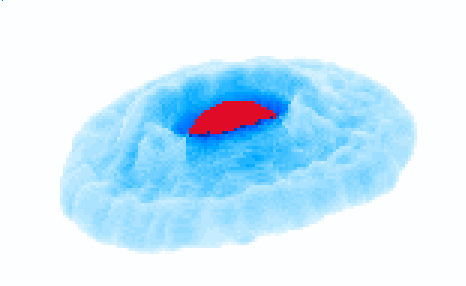First 3-D images of Jupiter's radiation belts
The first 3-D views of Jupiter's radiation belts have been made with data taken by the Australia Telescope Compact Array (ATCA). These views give us the characteristics of the belts at 1.3-4 Jupiter radii, confirming and extending models of Jupiter's magnetosphere that were based on measurements made by spacecraft much further out.

3-D tomographic reconstruction of Jupiter's radiation belts
Copyright © CSIRO
Copyright © CSIRO
The ATCA was used to observe Jupiter in July 1995, as part of a program to monitor the disruption caused by Comet Shoemaker-Levy 9. Several radio observatories had found that the comet's impacts increased the synchrotron emission from Jupiter's radiation belts by 10-45%, the amount varying with wavelength. Observatories with high angular resolution (such as the US Very Large Array and the ATCA) also found that this increase appeared mainly on one side of the planet, and that after the impacts the radiation belts came slightly closer to the planet. However, the observations made in July show that Jupiter has now returned to its pre-comet state.
As Jupiter has a rotation period of about 10 hours, the planet's longitude facing Earth at any given sidereal time changes by about 150° a day. The July observations, taken over 10 days, studied Jupiter at all longitudes. They were turned into a series of 18 two-dimensional projections of the planet, in the conventional way. The observers then realised that this set of 2-D projections of a transparent object could be used to build a 3-D tomographic reconstruction of the object. (In fact, a 3-D image of the radiation belts could be made directly, since a radio interferometer's response to a 3-D transparent object is a sample of the object's 3-D Fourier transform.) This is the first such 3-D image of Jupiter's radiation, and probably the first 3-D volume reconstruction of any non-terrestrial object.
From the 3-D view we can deduce the topology and the relative strength of Jupiter's magnetic field close to the planet. These characteristics have been fed back into existing models of the magnetic field, models based on measurements made by Pioneer and Voyager spacecraft. The characteristics of the field now seem to account entirely for the features of the radiation belts: there is no longer any need to invoke, as some earlier work did, excess abundances of electrons at some longitudes or electric fields induced by dawn and dusk on the planet.
G. Dulk, Y. Leblanc (Observatoire de Meudon); R. Sault (ATNF); R. W. Hunstead (Sydney University)
More:
News
Public
